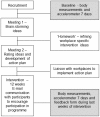Participatory workplace interventions can reduce sedentary time for office workers--a randomised controlled trial
- PMID: 24265734
- PMCID: PMC3827087
- DOI: 10.1371/journal.pone.0078957
Participatory workplace interventions can reduce sedentary time for office workers--a randomised controlled trial
Abstract
Background: Occupational sedentary behaviour is an important contributor to overall sedentary risk. There is limited evidence for effective workplace interventions to reduce occupational sedentary time and increase light activity during work hours. The purpose of the study was to determine if participatory workplace interventions could reduce total sedentary time, sustained sedentary time (bouts >30 minutes), increase the frequency of breaks in sedentary time and promote light intensity activity and moderate/vigorous activity (MVPA) during work hours.
Methods: A randomised controlled trial (ANZCTR NUMBER: ACTN12612000743864) was conducted using clerical, call centre and data processing workers (n = 62, aged 25-59 years) in 3 large government organisations in Perth, Australia. Three groups developed interventions with a participatory approach: 'Active office' (n = 19), 'Active Workstation' and promotion of incidental office activity; 'Traditional physical activity' (n = 14), pedometer challenge to increase activity between productive work time and 'Office ergonomics' (n = 29), computer workstation design and breaking up computer tasks. Accelerometer (ActiGraph GT3X, 7 days) determined sedentary time, sustained sedentary time, breaks in sedentary time, light intensity activity and MVPA on work days and during work hours were measured before and following a 12 week intervention period.
Results: For all participants there was a significant reduction in sedentary time on work days (-1.6%, p = 0.006) and during work hours (-1.7%, p = 0.014) and a significant increase in number of breaks/sedentary hour on work days (0.64, p = 0.005) and during work hours (0.72, p = 0.015); there was a concurrent significant increase in light activity during work hours (1.5%, p = 0.012) and MVPA on work days (0.6%, p = 0.012).
Conclusions: This study explored novel ways to modify work practices to reduce occupational sedentary behaviour. Participatory workplace interventions can reduce sedentary time, increase the frequency of breaks and improve light activity and MVPA of office workers by using a variety of interventions.
Trial registration: Australian New Zealand Clinical Trials Registry ACTN12612000743864.
Conflict of interest statement
Figures
References
-
- Hamilton MT, Hamilton DG, Zderic TW (2007) Role of low energy expenditure and sitting in obesity, metabolic syndrome, Type-2 diabetes, and cardiovascular disease. Diabetes 56: 2655–2667. - PubMed
-
- Healy GN, Dunstan DW, Salmon J, Cerin E, Shaw JE, et al. (2008) Breaks in sedentary time. Diab Care 31: 661–666. - PubMed
-
- Healy GN, Wijndaele K, Dunstan DW, Shaw JE, Salmon J, et al. (2008) Objectively measured sedentary time, physical activity, and metabolic risk. Diab Care 31: 369–371. - PubMed
-
- Hu FB, Li TY, Colditz GA, Willett WC, Manson JE (2003) Television Watching and Other Sedentary Behaviours in Relation to Risk of Obesity and Type 2 Diabetes Mellitus in Women. JAMA 289: 1785–1791. - PubMed
-
- Tremblay MS, Colley RC, Saunders TJ, Healy G, Owen N (2010) Physiological and health implications of a sedentary lifestyle. Appl Physiol Nutr Metab 35: 725–740. - PubMed
Publication types
MeSH terms
LinkOut - more resources
Full Text Sources
Other Literature Sources
Medical
Miscellaneous



